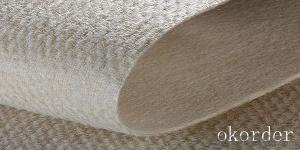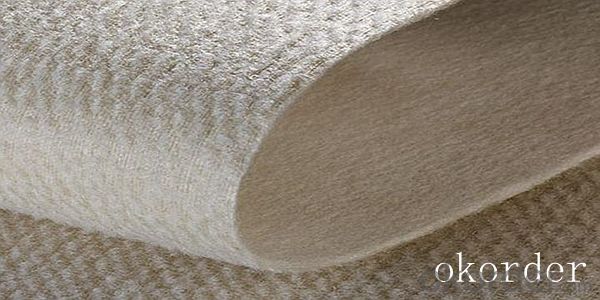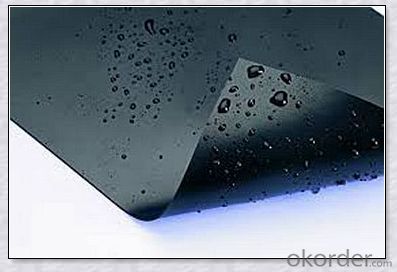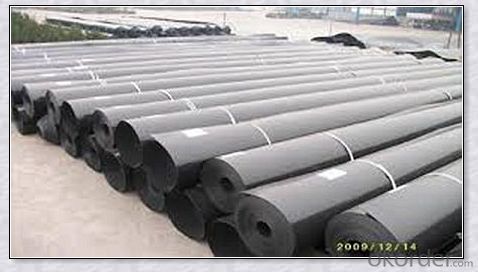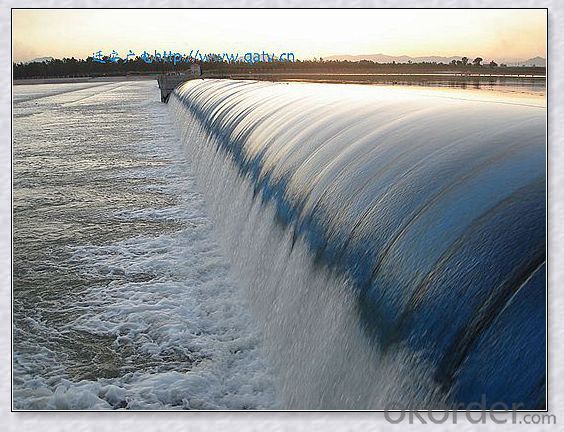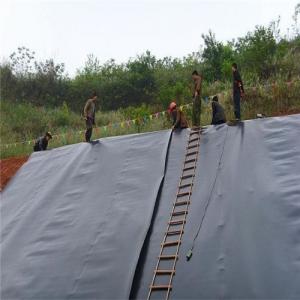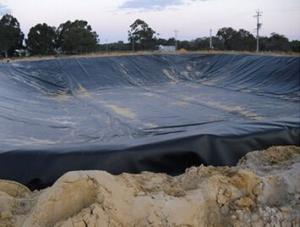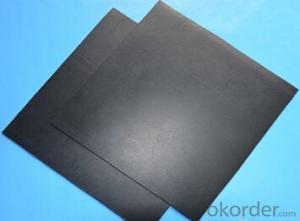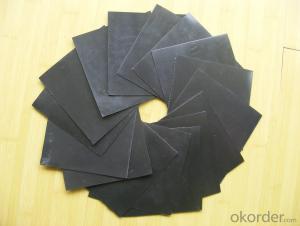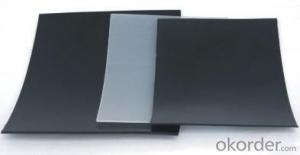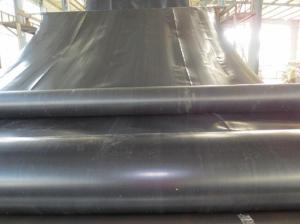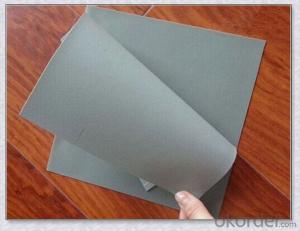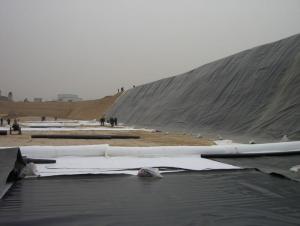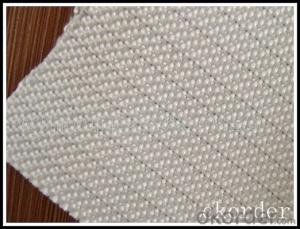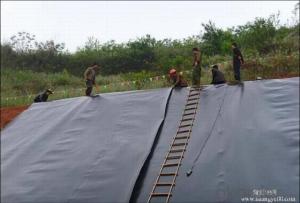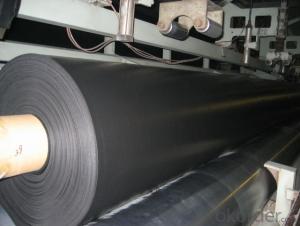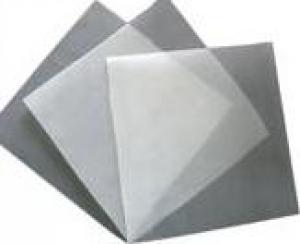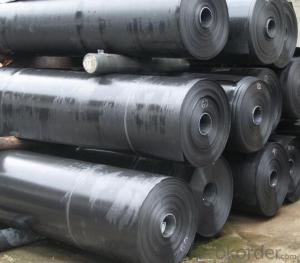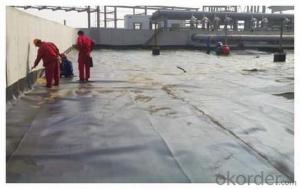Polypropylene HDPE Geomembrane for Reserve Water
- Loading Port:
- China main port
- Payment Terms:
- TT OR LC
- Min Order Qty:
- 1000 m²
- Supply Capability:
- 10000000 m²/month
OKorder Service Pledge
OKorder Financial Service
You Might Also Like
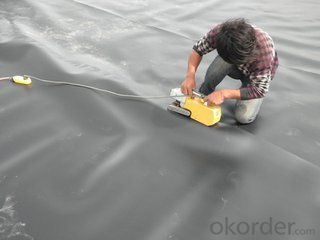
1. Product Introduction
Thickness
1mm-3.0mm
width
4-9m
Length
50-100m or as customers' requests
Material
LDPE, LLDPE, HDPE, EVA, ECB, PVC , CPE
Color
Black, white, green, blue, red, grey, and others
Port
Qingdao
Delivery
2-20 days
Packing
woven bag or as customers' requests
Function:
1.Geotextile has good air and water permeability to let water flow through it so as to effectively control sandrock running-down.
2.Geotextile has good water transmissibility, it can form drainage channels inside soil mass to drain redundant liquid and air out of the soil mass.
3.Geotextile helps to enhance the soil mass' tensile strength and non-deformability and structural stability so as to improve soil mass quality.
Features:
1.It can effectively make the concentrated stress diffuse, transfer or decompound, and prevent the soil mass against the destruction of outside force.
2.It can prevent the mixture of sandstone, soil mass and concrete of upper and lower layers.
3.Its mesh is hard to jam by virtue of the compliancy and motility of the reticulation formed by indefinite form fibrous tissue.
4.High water permeability-it can keep good water permeability even in the pressure of soil and water.
5.Corrosion resistant-it is made from polypropylene fiber or terylene or other chemical fiber, featuring resistance to acid and alkali and oxidation, non-corroding, no worm-eaten.
6.Easy construction-low weight, easy operation, simple construction
Our Service
Quality assurance
1.On a regular basis or as per your request,we entrust national testing agencies to conduct quality inspections
2. Strictly in accordance with the ISO9001-2008 international quality system standard,we monitor and manage the whole process throughout production,quality testing,and measurement to ensure product quality
3. For quality-related construction delay or substandard construction(except for damage or losses due to customer’s responsibility or irresistible natural disasters),we have refunding,replacement,and repair services.We will respond to customers’ feedbacks on quality issues within 24 hours.
Packaging & Shipping
Packing: PLASTIC FILM INSIDE, AND WOVEN BAG OUTSIDE
Shipping: About 15 days after receipt the deposit
FAQ:
Q: What kind of payments does jenor support?
A: T/T, L/C, Cash are accepted.
Q: Do you charge for the samples?
A: Accordeing to our company policy, the samples are free, we only charge the freight fee. And we will return the freight fee during the next order.
Q: Can you produce according to customers' design?
A: Sure, we are professional manufacturer, OEM and ODM are both welcome.
Q: Do you have other products?
A: Yes, please check the pictures:
- Q: What's the installation method of the soft film ceiling?
- Installation method: 1. First to go to the site to see if there is a condition of installing the keel: Look at the scene to check if the wall is completed, and whether the woodworking processing part is qualified, the plastering needed parts should be completed first. Special attention should be paid to the carpentry part of the requirements we have to do, lights, air vents, such as the size of the opening to be processed in advance. 2. If the on-site situation is permmited, the first is to fix the aluminium?alloy keel according to the requirement of the drawing design. The corner must be flat smooth, and the lighter should be flat and dense. 3. Pay attention to the lamp holder, air port, and light tube plate that need to be on the same level with the aurrounding keel. And it is required to be stable and smooth that can not swing. 4. The smoke and ceiling lamps should be first positioned and make a wooden frame with a smooth surface. Pay attention to the level, if it is too low, it is easy to highlight the traces of the underframe. 5. Before the installation of smallpox, the joint of the keel should be carefully checked, and the spray header should be sticked with the white tape. And the outlet should be handled well. When installing the smallpox, it should be fixed from the middle to the sides. Pay attention to both sides of the size, and the welding seam should be straight to the final corner and the surface should be smooth. After the surrounding is done, the excessive smallpox should be removed. To achieve the perfect side effect.
- Q: What are the considerations for geomembrane selection in fish farming ponds?
- When selecting a geomembrane for fish farming ponds, several considerations need to be taken into account. Firstly, the geomembrane should be made from a material that is resistant to punctures and tears, as fish can potentially damage the liner. Secondly, the geomembrane must be able to withstand exposure to various chemicals and water treatments used in fish farming, without deteriorating or releasing harmful substances into the pond. Thirdly, UV resistance is crucial to prevent degradation from prolonged exposure to sunlight. Additionally, the geomembrane should have low permeability to prevent water seepage and maintain proper water levels. Lastly, the cost and ease of installation should also be considered to ensure the selection of a geomembrane that meets both technical requirements and budget constraints.
- Q: Are geomembranes effective in preventing soil contamination?
- Yes, geomembranes are effective in preventing soil contamination. They act as a barrier between the soil and potential contaminants, preventing them from infiltrating and polluting the soil. Geomembranes are impermeable and resistant to chemical degradation, making them highly reliable in containing hazardous substances and preventing their migration into the soil.
- Q: How to deal with the white edge of sticking the film?
- It is the problem of tempered film quality, there is no practical way to solve, only to chage a film. If you do not mind, it can also be used; or you can try to press it down by your nails, it can be used if it is pressed down without rebound . Generally, it will appear the white edge, that is not the full coverage of the tempered film. There is a gap between the four sides of full coverage of the tempered film and the screen, which is not called the white edge.
- Q: Can geomembranes be used in decorative koi ponds and water gardens?
- Yes, geomembranes can be used in decorative koi ponds and water gardens. They provide a reliable waterproof barrier to prevent water leakage and can be easily customized to fit the shape and size of the pond or garden. Furthermore, geomembranes offer long-lasting durability and are resistant to various environmental factors, making them an ideal choice for such applications.
- Q: How do geomembranes prevent landfill odor emissions?
- Geomembranes prevent landfill odor emissions by acting as a barrier between the waste and the surrounding environment. They are impermeable to gases, preventing them from escaping into the air and causing unpleasant odors.
- Q: What is the typical width of a geomembrane in a mining application?
- The typical width of a geomembrane in a mining application can vary depending on the specific requirements of the project, but it is commonly found in widths ranging from 5 to 10 meters.
- Q: How do geomembranes contribute to wetland and pond restoration?
- Geomembranes can contribute to wetland and pond restoration by providing an impermeable barrier that prevents water seepage. By effectively containing water, geomembranes help in creating or restoring the necessary hydrological conditions in wetlands and ponds, promoting the growth of diverse aquatic vegetation and supporting the establishment of a healthy ecosystem. Additionally, geomembranes can also be used to control water levels and prevent erosion, contributing to the overall stability and longevity of wetland and pond restoration projects.
- Q: the specification of composite geo-membrane
- composite geo-membrane (composite seepage-proof film) is divided into one cloth and one membrane and two cloths one film, width 4-6m, weight 200- , 1500g/ square meter, pulling-resistance, tear-resistance, bursting and other high physic mechanics performance indicator, the products is high strength, and has good extensibility, large deformation modulus, acid and alkali resistance, errosion resistance, aging-resistance, seepage-proof and other characteristics. it will satisfy the seepage-proof, isolation, reinforce, anti-cracking and other soil engineering demands in water?conservancy, municipal, buildings, transport, metro, tunnel, and engineer construction. Because it has selected polymer materials and the production process is added with anti-aging agent, it can be used in unconventional temperature environment. it's commonly used in the seepage-proof treatment of dams, drainage ditch, and pollution prevention treatment of waste storage. one cloth one membrane is a kind of composite geotextile material. Mainly used in water conservancy, transportation, tunnels, airports, metallurgical tailings, waste disposal sites, roofing seepage and other reinforced seepage control.
- Q: Which one should be used for p lanting lotus, woven geomembraneor or blow molding geomembrane?
- Its anti-seepage effect is not as good as composite geomembrane and the cost of it is much higher than the composite geo-membrane. There are woven geotextile and composite woven geomembrane. Woven geotextile is not seepage-proof. Currently the seepage-proof geomembrane for planting lotus is generally blow molding geomembrane or composite geo-membrane.Composite woven geomembrane is seepage-proof. There isn't a product named wowen geomembrane.
Send your message to us
Polypropylene HDPE Geomembrane for Reserve Water
- Loading Port:
- China main port
- Payment Terms:
- TT OR LC
- Min Order Qty:
- 1000 m²
- Supply Capability:
- 10000000 m²/month
OKorder Service Pledge
OKorder Financial Service
Similar products
Hot products
Hot Searches
Related keywords
